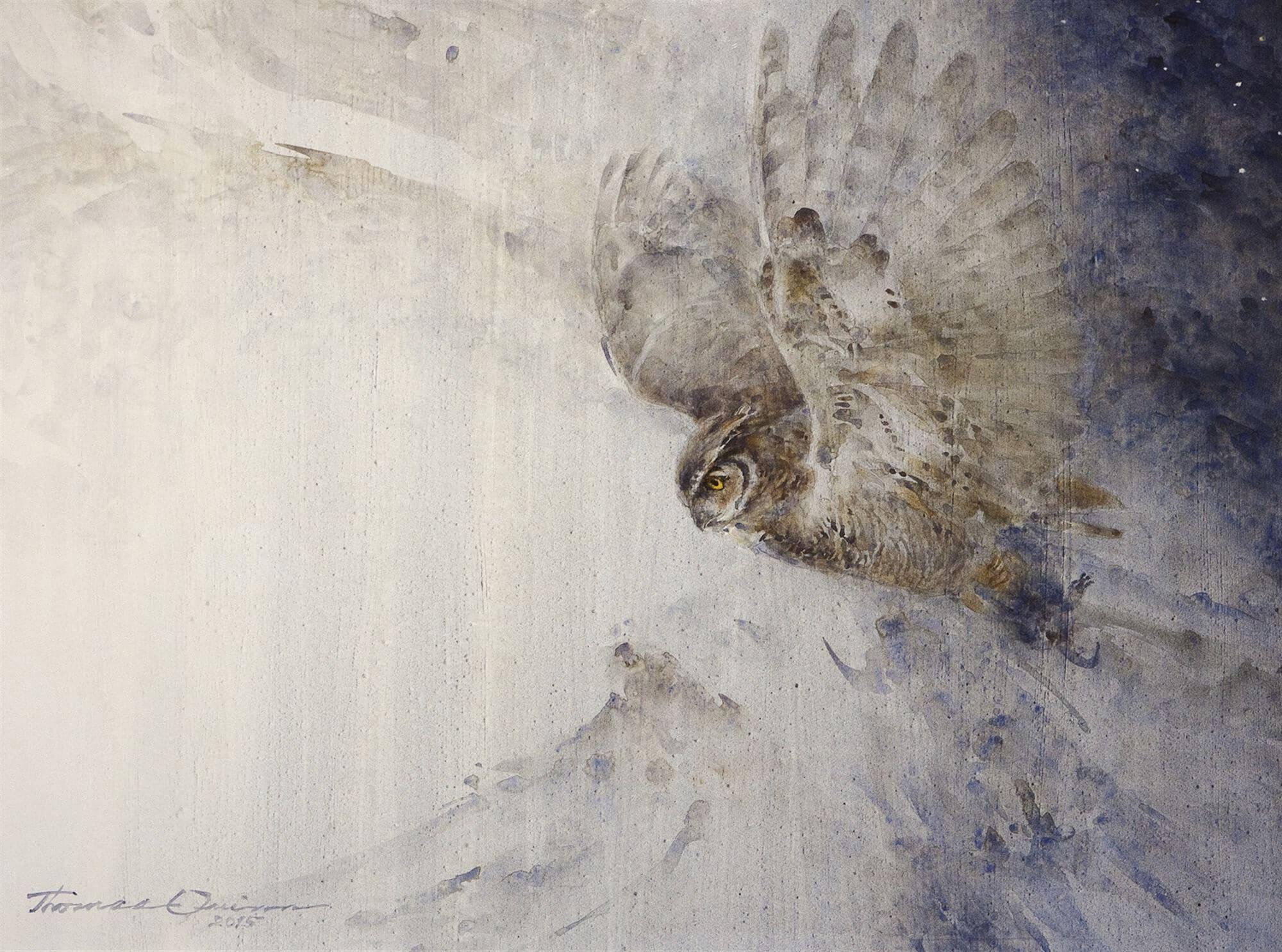
07 Nov The West Untamed
As much as the West has always been defined by its landscapes, Native American tribes, pioneers, and ranchers in the imaginations of people across the nation and around the world, the region’s wild animals may well be the subjects that most excite artists, collectors, and art lovers alike. So, when Wild West: Wildlife Masters Past and Present opens on December 1 at the Steamboat Art Museum, the exhibition will likely draw record crowds to an institution that — since first opening in 2006 in a historic 1920 bank building in downtown Steamboat Springs, Colorado — has welcomed more than 150,000 visitors in a town with a population of just 12,000 people.
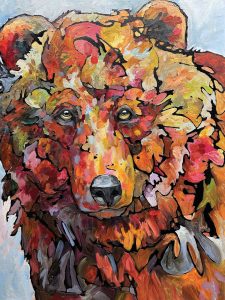
Amy Ringholz, Fog Lifter | Ink and Oil on Canvas | 40 x 30 inches
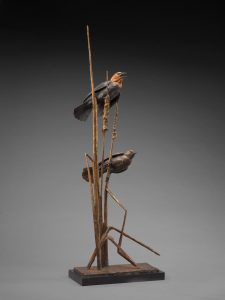
Walter Matia, Talkin’ ‘Bout My Girl | Bronze | 41 x 16 x 8 inches
“We’ve developed a niche reputation for presenting exhibits of living masters whose work reflects and enhances the culture and heritage of the West,” says Betse Grassby, the museum’s executive director. “This exhibition exemplifies what we have become known for, by telling the story of the development of Western wildlife art through the talent and vision of the finest artists of the genre, expressing and interpreting the wonderful untamed life and spirit of the West.”

Sally Maxwell, A Circle of Life | Scratchboard | 24 x 18 inches
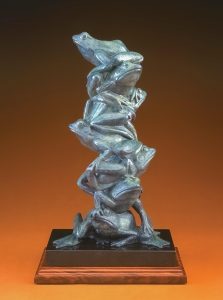
Tony Hochstetler, Stacked Frogs | Bronze | 14.5 x 8 x 6 inches
To make such an ambitious project possible, Grassby called on a widely respected expert in the field of American, and even more specifically Western, representational art: none other than Tim Newton, Western Art & Architecture magazine’s publisher, who from 2011 to 2019 served as Chairman of the Board and CEO of New York City’s Salmagundi Club, a century-and-a-half-old arts institution whose past illustrious members have included Thomas Moran, William Merritt Chase, Louis Comfort Tiffany, Emil Carlson, N.C. Wyeth, and Childe Hassam. “As our guest curator for this exhibition,” Grassby says, “Tim understands the living masters, and he is so highly respected by everyone in the art world for the amazing eye he has as a collector.” Add to that the fact that Newton is a dyed-in-the-wool Rocky Mountain Westerner, having grown up in Wyoming and Colorado.
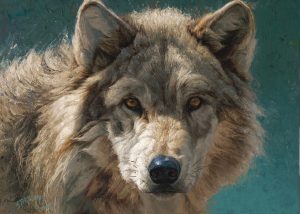
Greg Beecham, Beware the Stranger | Oil on Linen | 18 x 24 inches
Drawing on his close personal connections, Newton has assembled a display of almost 100 paintings and sculptures from some 30 top artists. These include five greats of the past who helped define the American wildlife genre: Carl Rungius [1869 – 1959], known for his oils of elk, caribou, grizzlies, mule deer, and Dall sheep; W. Herbert Dunton [1878 – 1936], a Taos Society of Artists founder, who rendered deer, elk, and bears in the Sangre de Cristos; renowned animal sculptor Anna Hyatt Huntington [1876 – 1973], who with her husband founded South Carolina’s Brookgreen Gardens, now a renowned outdoor art museum and wildlife preserve; Bob Kuhn [1920 – 2007], who brought skills developed as a top illustrator to his richly evocative scenes of animals ranging from bison to jackrabbits; and Lanford Monroe [1950 – 2000], who eloquently captured through her oils and bronzes Western wildlife amidst their natural habitats. “We’re borrowing these pieces by legendary masters to provide historic context for the living artists on view,” Newton says.
“There is a sacred quality to a lot of this art. These painters are people who love the natural world, and you could say their paintings are a ministry that speaks on behalf of the conservation and protection of animals. They commune with nature, and this work comes from deep in their souls.”
— Tim Newton, guest curator for Wild West: Wildlife Masters
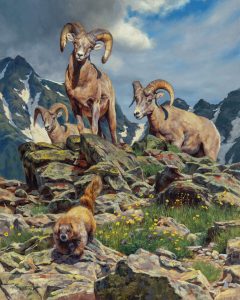
Dustin Van Wechel, The Introvert | Oil on Linen | 30 x 24 inches
The present-day greats in the exhibition, Newton hastens to add, are by no means being singled out as the only ones worthy of inclusion. “There are outstanding artists who are not in the show simply because of a lack of space or time,” he says. “We simply could not contain all of the fine wildlife artists working today.” Nonetheless, the list of participants, all of whom answered Newton’s invitation, looks like a roll call of the top artists working in the genre today.
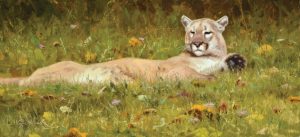
Kyle Sims, Contentment | Oil | 11 x 24 inches
Take, by way of example, two of the sculptors sending works to Steamboat. Sandy Scott, who lives close to many of the subjects she depicts in Lander, Wyoming, has built an unparalleled career over the past five decades-plus as one of the nation’s leading wildlife artists, first in drawing and printing and then in bronze. “I’m really excited about this show,” she says, adding that she’ll be exhibiting her recent The Herd Bull, a proud rendition of an American bison. “This iconic mammal’s largest population today resides in Yellowstone National Park, two hours from my studio. It is more than an animal to me. It is an emotional manifestation that exemplifies my deep affinity for the West and its history.”
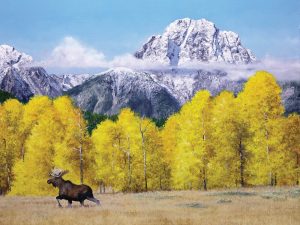
Mark Kelso, Transitions | Oil on Panel | 12 x 16 inches
By contrast, Walter T. Matia — whose “breadth of accomplishments,” says Newton, “is massive,” and includes most recently winning the Purchase Award from the 2023 Prix de West at the National Cowboy & Western Heritage Museum — is including Talkin’ ’Bout My Girl, an elegant representation of two yellow-headed blackbirds he spied clinging to a cluster of cattail stalks in New Mexico’s Bosque del Apache National Wildlife Refuge. “Birds, in general, are inherently weightless,” he says of the sculpture. “My job is to engineer that weightlessness.”
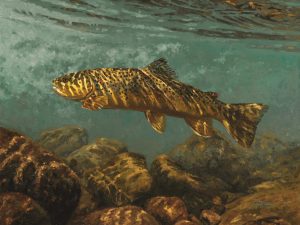
Jim Bortz, Tail Out | Oil | 18 x 24 inches
Equal expertise can be witnessed across the board among the painters in Wild West: from Utah-based artist James Morgan, “a quiet master whose work can really sneak up on you, tightly realistic and yet,” Newton continues, “very abstract, contemporary, and modern” in his compositions; to Greg Beecham, a full-time wildlife painter from Dubois, Wyoming, who, says Newton, “portrays animals in their habitats in a way that is completely believable”; to Colorado Springs-based artist Ezra Tucker, “who brings wonderful energy and an incredible sense of scale,” says Newton, to animal subjects as diverse as mountain lions and coyotes, elk and Western barn owls. “To be surrounded by other artists I admire in an exhibition like this is a heck of a compliment,” says Tucker of his invitation to join the show.
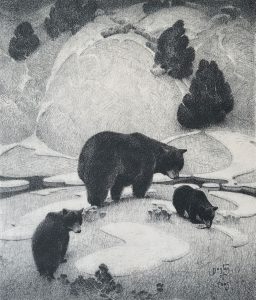
William Herbert “Buck” Dunton, The Mountain Mother, Black Bear and Cubs | Etching #19 | 12 x 10 inches
Adding yet another perspective to the gathering is Amy Ringholz, who has her studio and gallery in Jackson, Wyoming, where she creates and shows animal images — such as Fog Lifter, her bold ink-and-oil painting of a bear — painted in a colorful, contemporary, but realistic style that Newton finds “bright, spontaneous, effervescent, and pure joy, with a high level of skill.” She comes to the show well appreciative of the company in which she’s been included. “Tim Newton is such an avid art collector and art historian, with such an eye and such a sphere of connections with artists, that his curating a show already puts it in its own high caliber,” says Ringholz.
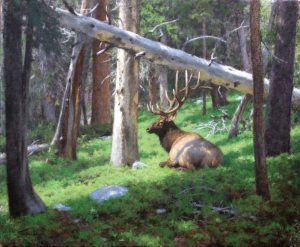
Tucker Smith, Sanctuary | Oil | 20 x 24 inches
As for Newton himself, he demurs from any such accolades, always turning the topic back to the subjects, the artists, and a deeper purpose behind their work. “These aren’t trophy paintings,” he emphasizes, referring to another art genre largely prized by game hunters. “There is a sacred quality to a lot of this art. These painters are people who love the natural world, and you could say their paintings are a ministry that speaks on behalf of the conservation and protection of animals. They commune with nature, and this work comes from deep in their souls.”
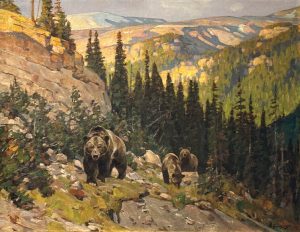
Carl Rungius, Out of the Canyon | Oil on Canvas | 28 x 36 inches
Wild West: Wildlife Masters Past and Present will be on view from December 1, 2023, through April 13, 2024, at the Steamboat Art Museum in Steamboat Springs, Colorado. Select works among the approximately 100 paintings and sculptures on view will be available for purchase.
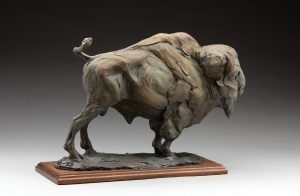
Sandy Scott, Herd Bull | Bronze | 13 x 21 x 7 inches






No Comments